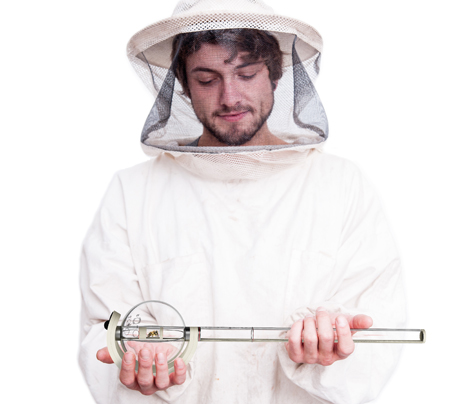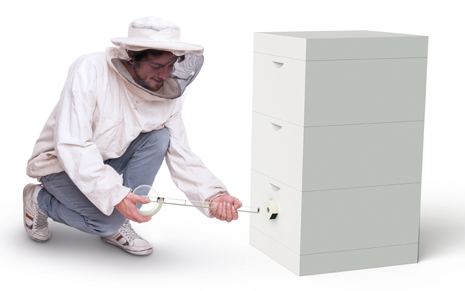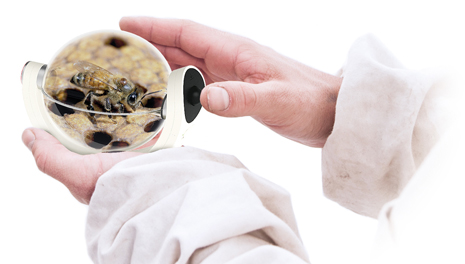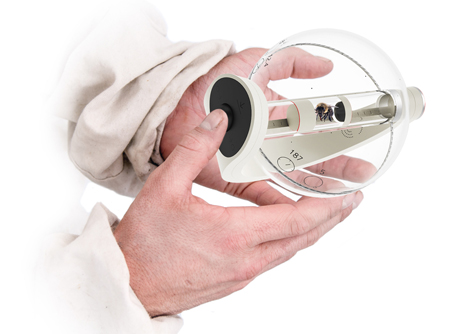
Mima is a minimal invasive monitoring assistant for apiarists, which allows for the monitoring of a hive without having to open it up
Being DEVELOP3D’s resident beekeeper, I made a beeline (pardon the pun) for the German national winner of this year’s James Dyson Awards.
These annual awards, run by the James Dyson Foundation, is open to current and recent design engineering students from all over the world.
Created by Lisa Reichardt, an industrial design student at Muthesius Academy of Fine Arts and Design Germany, Mima allows apiarists to inspect a beehive without having to open it up.

The Mima is inserted in the hive through an opening in the brood box
Essentially, the instrument is inserted into the hive through an opening in the brood box where various conditions can be monitored such as temperature, humidity and noise levels. There is also a small camera to examine the brood pattern and an individual bee can even be sucked out for closer examination.
Reichardt’s starting point for her project was the realisation that in China there are insufficient bees to pollinate all the plants that need to be. She’d also heard of the mysterious bee deaths that had swept through areas of North America.
With more and more people taking up ‘backyard beekeeping’ and becoming an ‘Apiarist 2.0’ (a new one on me) she wanted to create a product that would make it easier for these hobby apiarists to check on the health of their bees at anytime without actually having to disturb them by lifting the roof off their home.

The camera will stream video from the brood frames. Here is a bee with a varroa mite embedded on the top of its thorax
During her research with local beekeepers she also discovered a serious issue that affects bees worldwide, except in parts of Africa and Australia, and that’s the varroa mite. These tiny mites attach themselves to the bees and if they are left to breed in the colony, will eventually destroy the entire hive. Perforations in the brood will indicate this and so will closer examination of a bee as the mite will be evident as they embed themselves on the top of the bee’s thorax. Varroa also causes the deformed wing virus, where essentially a bee’s wings do not grow.
With Mima, the apiarist will be able to ‘suck out’ an individual bee and monitor it more closely. However, this pneumatic function of the product caused the biggest design challenge for Reichardt.

Through a pneumatic function in the instrument, an individual bee can be ‘sucked out’ of the hive for closer inspection
She continued to refine her design with mock-ups and eventually landed on a spherical shape for the product.
“The idea of creating new ways of experiencing bees and at the same time an intuitive flow of information for the apiarist accounts for the spheric form,” explains Reichardt.
The design is commendable and shows thought into how apiarists can monitor their bees without disturbing them. However, being a beekeeper, my only concern is when the instrument is inserted into the hive and the frames gently pushed apart through the twisting of the metal ‘lock’ (see video at the end). Bees glue everything inside the hive together with propolis and if there are any gaps between frames (anything bigger than a beespace) they will fill it with brace comb. So, there may have to be a ‘tunnel’ of some sort within the hive to guide the instrument inside. Another design challenge to address possibly.
But the Mima is just one of the 600 entries submitted into the James Dyson Awards, which on the 18th September saw the 600 entries whittled down to the best five projects from each country. These national winners and finalists will be further scrutinised by the judges and a shortlist of 20 announced on 16 October, with the overall international winner revealed on 6 November.
To browse the rest of the winning projects alongside the Mimi in this round, view the project gallery here.
//www.youtube.com/embed/oc9uMcOkZfM






